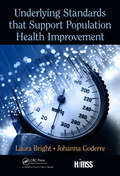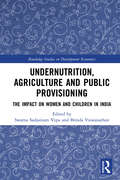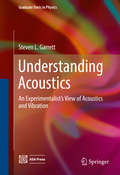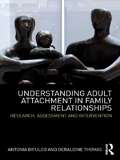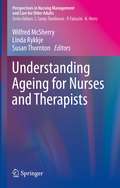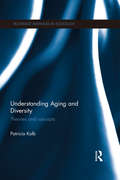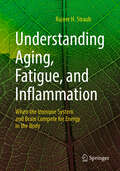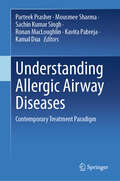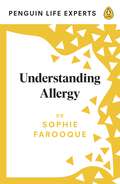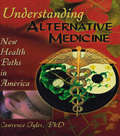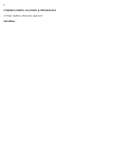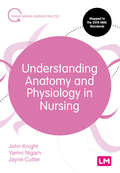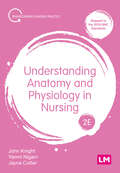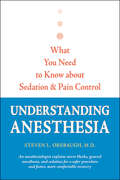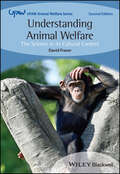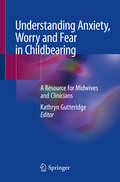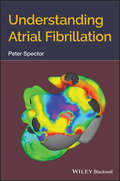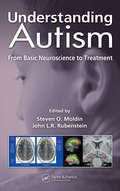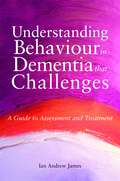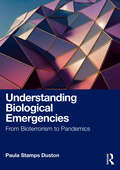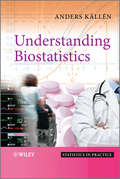- Table View
- List View
Underlying Standards that Support Population Health Improvement (HIMSS Book Series)
by Laura Bright Johanna GoderreThis book highlights success stories and challenges to implementing health IT standards. The narrative of each chapter demonstrates how standards further interoperable health data exchange, especially in the service of advancing tools to monitor population health. These are critical stories that demonstrate to an international community of health and IT experts how to bring the right stakeholders together and bridge classic divides between software architects and clinical end users, health system decision-makers and standard authors.
Undernutrition, Agriculture and Public Provisioning: The Impact on Women and Children in India (Routledge Studies in Development Economics)
by Swarna Sadasivam Vepa Brinda ViswanathanUsing quantitative techniques, this volume provides empirical evidence on the crucial role of public provisioning of food, water, sanitation and health care in reducing undernutrition among women and children in India. The linkages are cogently explored and connected to the sustainable development goals. Key data comes from recent large secondary sources at district, household and individual levels and the econometric methodologies are clearly explained. Taken as a whole, it highlights the effects of public provisioning on malnutrition and identifies the relative importance of agricultural growth in resolving the nutrition problems in rural and semi-urban areas of India. This edited volume will be valuable reading for advanced graduate students, researchers and practitioners in development economics, development studies, and nutrition and public health.
Understanding Acoustics
by Steven L. GarrettThis textbook provides a unified approach to acoustics and vibration suitable for use in advanced undergraduate and first-year graduate courses on vibration and fluids. The book includes thorough treatment of vibration of harmonic oscillators, coupled oscillators, isotropic elasticity, and waves in solids including the use of resonance techniques for determination of elastic moduli. Drawing on 35 years of experience teaching introductory graduate acoustics at the Naval Postgraduate School and Penn State, the author presents a hydrodynamic approach to the acoustics of sound in fluids that provides a uniform methodology for analysis of lumped-element systems and wave propagation that can incorporate attenuation mechanisms and complex media. This view provides a consistent and reliable approach that can be extended with confidence to more complex fluids and future applications. Understanding Acoustics opens with a mathematical introduction that includes graphing and statistical uncertainty, followed by five chapters on vibration and elastic waves that provide important results and highlight modern applications while introducing analytical techniques that are revisited in the study of waves in fluids covered in Part II. A unified approach to waves in fluids (i. e. , liquids and gases) is based on a mastery of the hydrodynamic equations. Part III demonstrates extensions of this view to nonlinear acoustics. Engaging and practical, this book is a must-read for graduate students in acoustics and vibration as well as active researchers interested in a novel approach to the material.
Understanding Adult Attachment in Family Relationships: Research, Assessment and Intervention
by Antonia Bifulco Geraldine ThomasAttachment theory has become a key focus of both research and practice in understanding and treating psychological and social risk for marital and relationship problems, parenting and clinical disorders. In particular, adult attachment style is a key explanatory factor for understanding problems in human relationships. This practical book introduces and explains an easily accessible assessment tool for adult attachment style, the Attachment Style Interview (ASI). Based on extensive research study, it discusses appropriate interventions and case assessments that can be made to help families in need. Simpler than the Adult Attachment Interview, which requires expert administration, the ASI is an invaluable and evidence-based resource. Presenting clear and concise descriptions of the measure and summaries of the attachment models developed, this text provides discussions of its relevance for different practice contexts, and uses a range of worked case studies to illustrate its principles and applications. It details attachment issues in different relationship domains to cover areas of risk and resilience relevant for practice such as: Adult depression and anxiety and stress models, Partner difficulties including domestic violence, Childhood neglect and abuse as a source of attachment problems, Parenting and intergenerational transmission of risk, Interventions, service application and use in family therapy. Understanding Adult Attachment in Family Relationships provides an important reference for all practitioners working with children, adolescents and families, especially those undertaking further study.
Understanding Ageing for Nurses and Therapists (Perspectives in Nursing Management and Care for Older Adults)
by Wilfred McSherry Linda Rykkje Susan ThorntonThis volume is a practical resource for all those responsible for caring for older people across health and social care. It provides a comprehensive and holistic approach helping nurses, therapists and social care professionals to better understand the impact of ageing upon the person and wider society. A unique feature of this text is the focus upon positive ageing and the attempt to dispel and challenge some of the myths, prejudices and negative attitudes that still prevail towards ageing and older people. A key objective of the book is to introduce practitioners to some of the neglected or under-addressed aspects of ageing such as spirituality, sexuality, and LGBT.Chapters are written in an engaging and interactive style and where appropriate draw upon case studies and scenarios to maximize engagement developing competence, by informing knowledge, attitudes and skills. The text introduces the practitioner to key dimensions of what it is to be a person, physically, psychologically, socially and spiritually and how these contribute to the ageing process and can enhance the quality of life of older people.Irrespective of whether one cares for older people in an acute hospital setting or domiciliary, home care, this text will be of relevance. The material and content transcend health and social care boundaries, providing valuable, contemporary evidence that can inform and shape practice. Above all this text will encourage reflection, dialogue and engagement with some fundamental aspects of ageing, challenging, attitudes, values and behaviour so that a more positive and balanced insight towards ageing is fostered. This book will ensure that self-awareness and professional practice are enriched and informed and the practitioner has a holistic understanding of ageing that will enable them to care for older people with compassion, dignity and respect.
Understanding Aging and Diversity: Theories and Concepts (Routledge Advances in Sociology)
by Patricia KolbThe demographic phenomena of increased life expectancy, increasing global population of older adults, and a larger number of older people as a proportion of the total population in nations throughout the world will affect our lives and the life of each person we know. The changes will result in challenges and benefits for societies and people of all ages. These events need to be understood, explained, and their consequences addressed; sociological theories about aging are an essential part of this process. In Understanding Aging and Diversity: Theories and Concepts, Patricia Kolb presents important sociological theories and concepts for understanding experiences of older people and their families in a rapidly changing world. She explores concepts from phenomenology, critical theory, feminist theory, life course theory and gerotranscendence theory to explain important issues in the lives of older people. This book investigates similarities and differences in aging experiences, focusing in particular on the effects of inequality. Kolb examines the relationship of ethnicity, race, gender, sexual orientation and social class to international aging experiences. This book explores the relationships between older people and social systems in different ways, and informs thinking about policy development and other strategies for enhancing the wellbeing of older adults. It will be useful for students and scholars of sociology, gerontology, social work, anthropology, economics, demography and global studies.
Understanding Aging, Fatigue, and Inflammation: When the Immune System and Brain Compete for Energy in the Body
by Rainer H. StraubIn this scientific non-fiction book, Rheumatologist and Professor of Experimental Medicine Rainer H. Straub holistically explains a central conflict in the body: why the battle for energy ages us and leads to fatigue, stress, sleep disorders, weight problems, libido issues, and hypertension. He explores how this particularly affects people with chronic inflammatory diseases. With fascinating insights, the author takes us on a journey into evolutionary biology, the present state of energy regulation, and the forward-looking field of psychoneuroimmunology. Learn to understand the connections between inflammatory processes and energy regulation in the body, drawing implications for dealing with diseases and therapeutic possibilities.
Understanding Allergic Airway Diseases: Contemporary Treatment Paradigm
by Kamal Dua Ronan MacLoughlin Kavita Pabreja Sachin Kumar Singh Parteek Prasher Mousmee SharmaThe book explores the intersection of nanotechnology and allergic airway diseases. With a focus on diagnosis and management, each chapter delves into specific areas of interest. Beginning with an introduction to the diseases, the book progresses to uncover the pathophysiology and immunology underlying allergic airway diseases. The epidemiology chapter provides insights into the prevalence and impact of these conditions. A significant portion of the book is dedicated to nanotechnology applications, with chapters on metal and metal oxide nanoparticles, nanomicelles, carbon nanotubes, liposomes, polymeric nanoparticles, solid lipid nanoparticles, dendrimers, nanofibers, and quantum dots. These chapters delve into the potential of these nanomaterials in managing allergic airway diseases, highlighting their unique properties, and promising therapeutic approaches. Finally, the book concludes with a chapter on future directions, exploring emerging trends and potential advancements in the field. This book will be a valuable resource for academics, caregivers, researchers, and industry professionals working in the field of airway allergic diseases. It includes translational and clinical researchers, under-graduates and postgraduates (Masters), PhDs, and post-doctoral researchers of various disciplines, including pharmaceutical sciences, biotechnology, immunology, and medical and health sciences.
Understanding Allergy (Penguin Life Expert Series #4)
by Dr Sophie FarooqueOne in three of us experiences allergies at some point in our lives and we are more allergic than ever before, so why are allergies still so misunderstood?In Understanding Allergy, Dr Sophie Farooque, a leading expert and consultant in allergy, will provide allergy sufferers and their families with the knowledge they need to help them navigate this minefield. The book will offer practical advice to reduce unnecessary suffering, debunk common allergy myths and address key topics including:· The allergy epidemic· Understanding and treating hay fever and rhinitis · Living with food allergies, delayed food allergies and anaphylaxis · Drug allergies· What to do if you think you have an allergy· Eczema and allergy preventionMany people who are allergic often struggle to access help, whilst many think they have an allergy when they do not - Understanding Allergy is the essential and concise guide to diagnosis, treatment and lifestyle changes, to help you manage and alleviate your allergies.________________________________ 'A fascinating, insightful guide that is extremely clear' Professor Adam Fox'A source of sound information and practical advice' Professor Roy Taylor'A must read' David Stukus, M.D
Understanding Alternative Medicine: New Health Paths in America
by Virginia M Tyler Lawrence TylerUnderstanding Alternative Medicine: New Health Paths in America provides health professionals and educators with insight into the growing use and social acceptance of alternative medicines in the United States today. This book discusses the political, economic, and scientific implications of multicultural medicine in American society and provides you with specific information on the use of alternative medicines in the United States. With this complete and comprehensive guide, you will discover the safety and efficacy of alternative medicines, therapies, and philosophies to offer your patients the best possible care for their ailments.Intelligent and informative, Understanding Alternative Medicine examines several different philosophies that alternative treatments are based on, such as Shamanism, Ayurvedic Medicine, and traditional chinese medicine and discusses some of the negative consequences of these practices on both the plant and animal kingdoms. This essential book will provide you with a variety of medical suggestions to improve your patients’health while examining present issues surrounding alternative medicine, including: realizing the environmental impact on endangered plants and animals used as ingredients in traditional and herbal medicines to help you understand the negative effects on the world while balancing the positive effects for the human population understanding the economic growth and social acceptance of the alternative health industry and its move into mainstream society examining why, according to some doctors’opinions, the United States Food and Drug Administration continues to be unsuccessful in its efforts to properly evaluate the safety and efficacy of alternative medicineThrough this essential book,you will discover how American medicine has diversified among accepted medical practices as well as medical practitioners and that these trends are beginning to change American health care practices and procedures. Understanding Alternative Medicine offers proof on how these changes have influenced the growing availability, awareness, and use of traditional medicines in order to expand your options for patient care and help people live improved and healthier lives.
Understanding Anatomy And Physiology: A Visual, Auditory, Interactive Approach
by Gale Sloan ThompsonHow do you learn A&P best? Whatever your learning style…by looking, listening, or doing, or a little bit of each…the 2nd Edition of this innovative, multiplatform approach to anatomy & physiology is designed just for you. Tackle a tough subject in bite-sized pieces. A seeming huge volume of information is organized into manageable sections to make complex concepts easy to understand and remember. You begin with an overview of the body, including its chemical and cellular structures, then progress to one-of-a-kind portrayals of each body system, grouped by function. A wealth of full-color illustrations, figures, sidebars, helpful hints, and easy-to-read descriptions make information crystal clear. Each unique page spread provides an entire unit of understanding, breaking down complex concepts into easy-to-grasp sections. Click here for a preview of the text & the accompanying resources. See. Listen. Do. Discover beyond the book with instructor and student resources online at DavisPlus, including your Davis Digital Version, full-color, narrated animations, interactive exercises, flash cards, and learning objectives/outcomes. Also available: Workbook to Accompany Understanding Anatomy & Physiology, 2nd Edition “The integration of graphics and text is very engaging for learners.
Understanding Anatomy and Physiology in Nursing (Transforming Nursing Practice Series)
by John Knight Yamni Nigam Jayne CutterCovering all the key aspects of anatomy and physiology that nursing students need to know, this text is the go to book for aspiring nurses. From an overview of cells, blood and how organ systems work together, through to coverage of each of the major organ systems, all the way to key developmental stages, genetics and ageing, this book distils the vast amounts of anatomy and physiology information that student nurses need to know into short, concise and easily accessible chapters. Throughout the book, case studies link core principles of anatomy and physiology to scenarios commonly encountered by nurses in clinical practice, helping students to apply this knowledge to their everyday working life. Key features • Mapped to the new NMC standards of proficiency for registered nurses (2018) • Case studies, activities and other learning features help students translate the theory to practice • Provides revision guidance and strategies for tackling exams and assessments throughout
Understanding Anatomy and Physiology in Nursing (Transforming Nursing Practice Series)
by John Knight Yamni Nigam Jayne CutterCovering all the key aspects of anatomy and physiology that nursing students need to know, this text is the go to book for aspiring nurses. From an overview of cells, blood and how organ systems work together, through to coverage of each of the major organ systems, all the way to key developmental stages, genetics and ageing, this book distils the vast amounts of anatomy and physiology information that student nurses need to know into short, concise and easily accessible chapters. Throughout the book, case studies link core principles of anatomy and physiology to scenarios commonly encountered by nurses in clinical practice, helping students to apply this knowledge to their everyday working life. Key features • Mapped to the new NMC standards of proficiency for registered nurses (2018) • Case studies, activities and other learning features help students translate the theory to practice • Provides revision guidance and strategies for tackling exams and assessments throughout
Understanding Anatomy and Physiology in Nursing (Transforming Nursing Practice Series)
by John Knight Yamni Nigam Jayne CutterCovering all the key aspects of anatomy and physiology that nursing students need to know, this second edition condenses vast amounts of scientific information into short, concise, and easily accessible chapters. It introduces aspiring nurses to all of the vital information on this tricky subject, from an overview of cells, blood, and the major organ systems through to key developmental stages, genetics and ageing. Case studies link core principles of anatomy and physiology to common real-world clinical scenarios, helping students apply this knowledge to their everyday working practice. Key features: - Each short chapter is mapped to the 2018 NMC Standards - Scientific information is broken down into easily digestible chunks with accompanying illustrations, to help aspiring nurses get to grips with this complex subject - Case studies, activities and other learning features help students translate the theory to practice - Provides revision guidance and strategies for tackling exams and assessments
Understanding Anatomy and Physiology in Nursing (Transforming Nursing Practice Series)
by John Knight Yamni Nigam Jayne CutterCovering all the key aspects of anatomy and physiology that nursing students need to know, this second edition condenses vast amounts of scientific information into short, concise, and easily accessible chapters. It introduces aspiring nurses to all of the vital information on this tricky subject, from an overview of cells, blood, and the major organ systems through to key developmental stages, genetics and ageing. Case studies link core principles of anatomy and physiology to common real-world clinical scenarios, helping students apply this knowledge to their everyday working practice. Key features: - Each short chapter is mapped to the 2018 NMC Standards - Scientific information is broken down into easily digestible chunks with accompanying illustrations, to help aspiring nurses get to grips with this complex subject - Case studies, activities and other learning features help students translate the theory to practice - Provides revision guidance and strategies for tackling exams and assessments
Understanding Anesthesia: What You Need to Know about Sedation and Pain Control (A Johns Hopkins Press Health Book)
by Steven L. OrebaughMost people choose their surgeon with care, but very few think about the anesthesiologist, even though that specialist's skills and approach can significantly influence the success of surgery. Here Dr. Steven L. Orebaugh recommends steps we all can take to secure safe and effective anesthesia. What type of anesthesia is used—and how it is applied—directly affects postoperative comfort as well as mental clarity and rehabilitation. This book describes the various options for anesthesia, how they can be used together for the best possible surgical outcome and optimal pain management, and their associated complications and risks. Dr. Orebaugh focuses especially on the benefits of regional anesthesia. When appropriately applied—whether alone or with other methods—spinal and peripheral nerve blocks often lead to better recovery and reduced pain. With as many as half of all surgical patients experiencing poorly controlled postoperative pain, regional anesthetic nerve blocks can help significantly in managing this pain while reducing the side effects of general anesthetics and pain medications. A better understanding of anesthesia will reassure people contemplating surgery and equip them to take the necessary steps toward healthy recovery. Knowing their options, they can have informed conversations with their doctor and indicate a preference for a specific anesthetic treatment. Written by a compassionate and experienced anesthesiologist and backed by scientifically accurate information and the latest research, this book will help patients do just that.
Understanding Animal Welfare: The Science in its Cultural Context (UFAW Animal Welfare)
by David Fraser"This is a delightful book, full of interesting aspects of animal welfare. An excellent guide to the academic study of animal welfare science."—Marian Stamp Dawkins, Department of Zoology, University of Oxford Understanding Animal Welfare: The Science in its Cultural Context takes a completely fresh and thought-provoking approach. It is essential reading for anyone interested, studying or currently working in the fascinating field of animal welfare science. David Fraser places modern-day welfare issues within their historical framework by tracing the evolving ideas that led to current thinking. He also highlights some intriguing issues relating to the contradiction inherent in the term 'animal welfare science' and the practical problem of how to assess emotional states in animals. Special features: Encompasses ideas from a variety of disciplines to give a broad perspective of the topic. Discusses methods of measuring animal welfare and their strengths and limitations. Examines contemporary debates and applications of the science to policy issues. "... an impressive historical narrative of the genesis and growth of animal welfare as a scientific discipline.... The book will be invaluable for anyone involved with animal welfare issues on an academic level or those involved with the integration of these principles into current care and handling issues facing agriculture, companion, laboratory, wild, or zoo animals."—Carolyn L. Stull, PhD, Veterinary Medicine Extension, School of Veterinary Medicine, University of California, Davis "Fraser offers insights only possible from someone with his considerable experience and understanding."—Dr. Chris Sherwin, Department of Clinical Veterinary Science, University of Bristol This book is part of the UFAW/Wiley-Blackwell Animal Welfare Book Series. This major series of books produced in collaboration between UFAW (The Universities Federation for Animal Welfare), and Wiley-Blackwell provides an authoritative source of information on worldwide developments, current thinking and best practice in the field of animal welfare science and technology. For details of all of the titles in the series see www.wiley.com/go/ufaw.
Understanding Animal Welfare: The Science in its Cultural Context (UFAW Animal Welfare)
by David FraserUnderstanding Animal Welfare The essential text on understanding and improving animal welfare Understanding Animal Welfare, 2nd Edition is revised and expanded to incorporate new research and developments in animal welfare. Updated with greater accessibility in mind, the reader is guided through animal welfare in its cultural and historical context, methods of study, and applications in practice and policy. Drawing examples from farm, companion, laboratory and zoo animals, the text provides an up-to-date overview of research and its applications, while also tracing how concepts and methods have evolved over time. Readers of the second edition of Understanding Animal Welfare will also find: New developments in understanding positive animal states The importance of human actions in determining animal welfare New content on “One Welfare” How free-living wild animals are affected by human technology and climate change Originally intended for scientists and professionals, Understanding Animal Welfare has also found a home in undergraduate classrooms. It is now the essential text for students, practitioners, veterinarians, and researchers in animal welfare and related fields.
Understanding Anxiety, Worry and Fear in Childbearing: A Resource for Midwives and Clinicians
by Kathryn GutteridgeThis book informs and enlighten health professionals on how the recognition of fearing women can change their episode of care during childbearing. It gives practical advice on the way women present to services and the challenges that this invokes. This work is the first of its kind aimed at clinicians to deconstruct ideology around childbearing myths and its challenges. The authors review the evidence that exists and how modern maternity systems are responding to fear and shaping healthcare. Whilst some worry and anxiety is expected and indeed considered normal during childbearing, it has been suggested that this has now proliferated to a degree of abnormal for many women. Why is that and how is this panic spread? Media portrayal of birth is suggested as unrealistic material and to show only that which is dramatic and horrific. This has been considered as one factor influencing modern women. Medicalisation, technology and demand upon services is another consequence of providing almost all maternity care in hospitals. Given that the majority of childbearing women are fit and healthy is this another causative factor? By removing women from their homes and families at such a vulnerable time has a serious consequence for how she will experience her greatest leap of faith into motherhood. All of these issues are explored and examined in the book with ideas and practical suggestions of what may be done to change this increasingly common problem. This book is intended at midwives and clinicians working in maternity settings.
Understanding Atrial Fibrillation: A Conceptually Guided Approach
by Peter SpectorA new guide to the mechanisms and principles behind the world’s most common abnormal heart rhythm Affecting 30 million or more people across the globe, atrial fibrillation is one of the most prevalent – and yet misapprehended – issues facing modern cardiology. Its potential causes and optimal treatment strategies are matters of some conjecture in the medical community, where ongoing research has yielded findings that can prove challenging to those not familiar with the complex physiology at the root of the condition. Recognizing these concerns, distinguished electrophysiologist Peter Spector has designed Understanding Atrial Fibrillation as a means by which to equip clinicians with the data and analytic tools needed to develop a better grasp of this arrhythmia’s full nature. The book begins by providing a detailed explanation of atrial fibrillation’s causal mechanisms and builds its exploration from there. Working toward an up-to-date knowledge of the mapping and ablation of atrial fibrillation, its chapters assess the experimental data that has shaped current thoughts on the condition and then outline the best methods with which to interpret that rich but potentially difficult information. This revelatory new guide: Explores hypotheses of multiple drivers and mechanisms co-existing in individual patients Addresses common misperceptions and inaccurate views about atrial fibrillation Describes the basic physiology of atrial fibrillation’s propagation and reentry Explores the various mechanisms and higher-order dynamics of fibrillation Discusses how to intervene and alter atrial physiology to prevent fibrillation Understanding Atrial Fibrillation is truly an invaluable resource for physicians, fellows, residents, electrophysiology lab staff, and all other practitioners involved in the diagnosis and treatment of atrial fibrillation.
Understanding Autism: From Basic Neuroscience to Treatment
by Steven O. Moldin John L.R. RubensteinTaking an all-inclusive look at the subject, Understanding Autism: From Basic Neuroscience to Treatment reviews state-of-the-art research on the diagnosis, treatment, and prevention of autism. The book addresses potential mechanisms that may underlie the development of autism and the neural systems that are likely to be affected by these molecular,
Understanding Biological Emergencies: From Bioterrorism to Pandemics
by Paula Stamps DustonThis book investigates the links between the main sources of biological emergencies and presents a comprehensive policy framework that seeks to achieve the ultimate goal of biological security.The work offers a new interdisciplinary approach to analyse the linkages between the three main sources of biological emergencies: intentional attacks, natural zoonotic transmission, and lab accidents. In doing so, the text describes the history of using nature to create a weapon, focusing on dispersal methods. The most important Select Agents for monitoring are described, with a special focus on anthrax and smallpox. The case studies presented include the use of the Biological Weapons Convention (BWC) in Iraq and the 2001 anthrax attack in the US. The policies that created the emergency preparedness system are analysed, and the current system is described in terms of their effectiveness in responding to the COVID-19 pandemic. The book concludes with some ideas and specific suggestions for moving from response to risk reduction and prevention.This book will be of much interest to students of biosecurity studies, public health, public policy, political science and international relations, and to professionals working in the fields of public health, public safety, medicine, nursing, and first responders as well as military personnel.
Understanding Biostatistics
by Anders KällénUnderstanding Biostatistics looks at the fundamentals of biostatistics, using elementary statistics to explore the nature of statistical tests.This book is intended to complement first-year statistics and biostatistics textbooks. The main focus here is on ideas, rather than on methodological details. Basic concepts are illustrated with representations from history, followed by technical discussions on what different statistical methods really mean. Graphics are used extensively throughout the book in order to introduce mathematical formulae in an accessible way.Key features:Discusses confidence intervals and p-values in terms of confidence functions. Explains basic statistical methodology represented in terms of graphics rather than mathematical formulae, whilst highlighting the mathematical basis of biostatistics. Looks at problems of estimating parameters in statistical models and looks at the similarities between different models. Provides an extensive discussion on the position of statistics within the medical scientific process. Discusses distribution functions, including the Guassian distribution and its importance in biostatistics. This book will be useful for biostatisticians with little mathematical background as well as those who want to understand the connections in biostatistics and mathematical issues.
Understanding Bipolar Disorder
by David Miklowitz Dante CicchettiThis is the first book to systematically examine the development and course of bipolar disorder across the lifespan, identifying important directions for evidence-based treatment and prevention. The editors and contributors are foremost authorities who synthesize cutting-edge research at multiple levels of analysis, including genetic, neurobiological, cognitive, emotional, and family perspectives. Compelling topics include how bipolar symptoms change from childhood through adolescence and adulthood and the interplay of risk and protective factors at different developmental stages. The volume also addresses how developmental knowledge can inform the selection and timing of clinical interventions.
